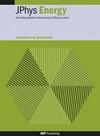通过在钠离子电池阴极的层状磷酸钒中引入 K 离子,增强 Na 离子的可逆插层作用
IF 6.3
3区 材料科学
Q1 ENERGY & FUELS
引用次数: 0
摘要
钒基磷酸盐作为钠离子电池(SIB)阴极的一个重要系列,正在被广泛研究。在众多成分中,NaVOPO4 因其多种多晶型态和 V4+/5+ 的高氧化还原电位而被考虑。然而,由于其内在动力学和电子传导性相对较差,人们通常采用纳米结构和碳复合材料等方法来避免性能快速下降。与主流方法不同,本研究利用从钾离子电池(PIB)中获得的知识,将层状 KVOPO4(一种 PIB 阴极材料)用作 SIB 阴极材料。研究结果表明,KVOPO4 在初始循环中经历了 K+-Na+ 交换的电化学过程,并在随后的循环中经历了以 Na 为主导的(去)插层过程。由于 K+ 的尺寸比 Na+ 大,残留的 K+ 有效地充当了 "支柱",扩大了层间距,促进了 Na 的(去)插层,从而使 KVOPO4 的可逆 Na 储存和扩散动力学比其对应的 NaVOPO4 更强。在 10 mA g-1 下,KVOPO4 的初始放电容量为 120 mAh g-1(理论容量的 90%),循环 150 次后仍能保持 88% 的容量。它还能在 1 A g-1 下提供 52 mAh g-1,在 100 mA g-1 下循环 1000 次后容量保持率为 91%,完全优于 NaVOPO4。本文章由计算机程序翻译,如有差异,请以英文原文为准。
Enhancing reversible Na-ion intercalation by introducing K-ions into layered vanadyl phosphate for sodium-ion battery cathodes
Vanadium-based phosphates are being extensively studied as an important family of sodium-ion battery (SIB) cathodes. Among many compositions, NaVOPO4 is considered because of various polymorphs and the high redox potential of V4+/5+. However, due to relatively poor intrinsic kinetics and electronic conductivity, approaches such as nanostructuring and carbon composites are commonly used to avoid fast performance degradation. Being different from mainstream approaches, this work utilizes the knowledge gained from potassium-ion batteries (PIBs) and applies layered KVOPO4, a PIB cathode material, as a SIB cathode material. The results demonstrate that KVOPO4 experiences an electrochemical K+-Na+ exchange during the initial cycle and a Na-dominated (de)intercalation process in the following cycles. The initial exchange results in a small amount of K+ (∼0.1 K per formula) remaining in the interlayer space and owing to the larger size of K+ than Na+, the residual K+ effectively acts as ‘pillars’ to expand interlayer spacing and facilitates the Na (de)intercalation, leading to enhanced reversible Na storage and diffusion kinetics of KVOPO4 compared to its Na counterpart NaVOPO4. KVOPO4 delivers an initial discharge capacity of 120 mAh g−1 (90% of the theoretical capacity) at 10 mA g−1 and retains 88% capacity after 150 cycles. It also delivers 52 mAh g−1 at 1 A g−1 and 91% capacity retention after 1000 cycles at 100 mA g−1, completely outperforming NaVOPO4.
求助全文
通过发布文献求助,成功后即可免费获取论文全文。
去求助
来源期刊

Journal of Physics-Energy
Multiple-
CiteScore
10.90
自引率
1.40%
发文量
58
期刊介绍:
The Journal of Physics-Energy is an interdisciplinary and fully open-access publication dedicated to setting the agenda for the identification and dissemination of the most exciting and significant advancements in all realms of energy-related research. Committed to the principles of open science, JPhys Energy is designed to maximize the exchange of knowledge between both established and emerging communities, thereby fostering a collaborative and inclusive environment for the advancement of energy research.
 求助内容:
求助内容: 应助结果提醒方式:
应助结果提醒方式:


